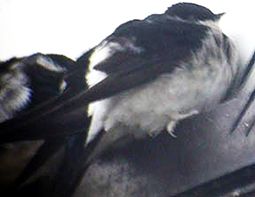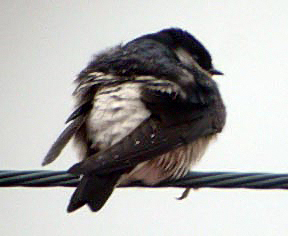of one on an island in the northwest in autumn in the mid-late 1990’s).

April 20 2003, Photo © Nial Moores
Following a prolonged warm spell, rain and fog covered much of the Yellow Sea on April 18th, with heavy rain showers continuing through the 19th (and into the 20th).
On the 19th, checking the increasing number of Red-rumped Hirundo daurica japonica (though perhaps now properly Lesser Striated Hirundo daurica) and Barn Swallows Hirundo rustica (gutturalis) perching up on wires in the village, one bird stood out immediately on account of its extensive white rump: a House Martin.
Expecting it to be an Asian House Martin Delichon dasypus (a local and rather uncommon migrant to South Korea), closer examination of the bird revealed some unexpected features: the rump, although fluffed up, looked much too extensive and clean white (lacking the dark streaking typical of Asian House), and the tail looked rather neatly forked - deeper than most Asian’s.
On the 20th, a second near-identical individual was also found in the village, at times perching within less than 1 m of the first. Although the lagopoda subspecies of Northern (the only subspecies likley to occur in South Korea) is considered by e.g. Robson (2000) to be "very similar" to Asian House Martin, the unexpected and welcome presence of an Asian House similarly perched up on wires only 5 m from the Northerns provided the very welcome and unusual opportunity for prolonged near-direct comparison of the two taxa.

April 19 2003, Photo © Nial Moores

April 19 2003, Photo © Nial Moores


Delichon urbica lagopoda,
April 19 2003, Photo © Nial Moores
With the lengthy studies possible, separation of lagopoda and dasypus proved more easy than expected:
- Asian House Martin generally looks small and compact, close to Sand Martin Riparia riparia in overall shape. The two Northerns looked larger and somewhat closer to nominate Northern House Martin D. u. urbica found in e.g. northwest Europe, with apparently longer primaries, and a slightly deeper tail cleft than Asian House;
- The two Northerns both showed very large white rump patches, with the white extending up the back, and down on to the uppertail coverts. The Asian House showed a narrower rump patch, with black uppertail coverts (appearing darker than the slightly faded-looking tail feathers);
- The Northerns showed pure white rumps - completely lacking any darker markings. The Asian House had a grey-washed rump, with clear dark streaks (shaft streaks?);
- Especially on the 20th, the two Northerns looked much whiter below, with clean white vents/undertail coverts. The bird of the 19th appeared rather sullied when fluffed up, but much whiter looking when holding its feathers more tightly. Asian House (in Japan and Korea at least) invariably look very sullied below, with an oil-stained browny grey wash, darkest across the breast, often/always with darker undertail coverts and a whiter-looking throat;
- Both Northerns showed clean white chins, with white feathering extending under the lower mandible. The Asian showed the typical very slight black feathering on the upper chin: easier to see at some angles than others;
- The dark of the crown extended to just below the eye in both Northerns, reaching down to the cutting edge or thereabouts. The dark seemed to extend slightly lower down on the Asian, to the base of the lower mandible, creating a subtly different effect;
- The white underlying the crown reached further and higher back on the Asian than in the two Northerns;
- The blue of the upperparts was cleaner and brighter in the two Northerns than in the Asian, that appeared (as is typical) more inky-looking;
- In flight, the underwing coverts of the Asian were clearly blackish, and the whole underwing looked dark (an effect noted even when preening). Although the underwing coverts (often cited as the key identification feature) were not seen as well in the Northerns, they clearly appeared paler, and more greyish against the sky, than the Asian House’s.
Lagopoda’s range is given as E Asia, S China, Burma, and Thailand in Howard and Moore (1991), partly overlapping the range of Asian House Martin.<
The taxonomic status of lagopoda is a subject of some debate.
Older works (eg Flint et al) view the entire House Martin group as just one species Delichon urbica with a cline from west to east, with lagopoda considered to be an intermediate taxon between the larger, brighter western urbica and the smaller and duller eastern dasypus.
Most current literature and opinion though favours the separation of dasypus as Asian House Martin (with three forms), and there is even a suggestion that lagopoda itself is a candidate for full species status (Des Allen pers comm).

Photo © Nial Moores

Photo © Nial Moores
As ever, we are very grateful for comment from birders/researchers, particularly those with experience of lagopoda, or the cashmiriensis form of Asian House Martin.
Comments
Steve Madge:"Excellent photos of lagopoda showing very extensive white on rump extending well down onto uppertail coverts; where lagopoda & dasypus meet they are very different as 2 extremes of these taxa. In the Baikal region of Buryatia, central Siberia I have found an interesting situation. This is what I wrote in our Limosa Holidays trip report for our 2001 tour:
"The colonies at Tankhoi (SE Lake Baikal) had shallow tail forks and white uppertail coverts as well as rump, typical of eastern ssp lagopoda, they also sounded slightly different to 'ours'. However the handful of birds in the town centre at Petropavlovka (border town with Mongolia, to south of Ulan Ude) appeared to be of the nominate race as they had prominent tail forks, a 'normal' rump and sounded very familiar. This is unusually far east for the nominate to occur (but many western species are spreading east in this part of the world) and it is tempting to suggest that if two are so different near a region of potential contact then perhaps they should be treated as separate species ? What with isolated populations of Asian House Martins breeding in the Sayan Mountains then this region could have 3 forms breeding in close proximity."
I shall be going back in a few weeks time and will take a closer look at the situation."
Paul Leader:"Clearly it is [lagopoda], and the whole account is extremely convincing and detailed. Anyhow, I have seen lagopoda in Xinjiang, and found it surprisingly similar to European birds, but very different to Asian. One feature you mention, the small amount of black below the bill - this is a feature I have noticed on all the Asians I have trapped in HK, and is never shown at least on Northern in the UK (I have handled 100s there). I was also impressed by the lack of streaking on the underparts of the Red-rumped - very different to HK birds."
Dr Martin Williams:"Partly based on past info (when I think specimens were collected), it seems Northern House Martin is a fairly scarce migrant thro Beidaihe area; think we have some info in one of the reports."
References:
- Swallows and Martins, Turner & Rose. 1989.
- A Field Guide to the Birds of South-east Asia, Robson (2000).
- A Complete Checklist of the Birds of the World, Howard and Moore (1991).
- A Field Guide to the Birds of Russia and Adjacent Territories (the former USSR). VE Flint, RL Boehme, YV Kostin and AA Kutnetsov (1983).
Whilst not strictly relevant, the following DPKR stamp was found on the internet!

For more info on the set this came from, go to www.bird-stamps.org/recent/korean/belgica2001.



